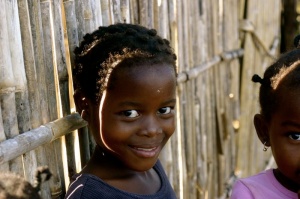At MEFCON 2008, I had the chance to speak to journalist/filmmaker L.M. Kit Carson and producer Cynthia Hargrave. They showed two of three short movies made in Mozambique, shot with the Nokia N93 cell phone and edited with Mac iMovie. I highly encourage MobilizedTV readers to make sure to watch this when it becomes available on the Sundance Channel in November.
Why? There are a lot of reasons why mobile TV/video is finding a hard time gaining momentum. Most of the conversation focuses on problems with handsets, networks, business models. We’ve left out the conversation on creativity, on what the medium can do.
I think there is a great paucity of imagination about the mobile medium, and that this lack of imagination is another, very significant roadblock in the development of mobile entertainment. Most people dismiss mobile as a display medium, and don’t even consider its possibilities as a production medium in its own right.
The importance of L.M. Kit Carson’s work is that it uses the mobile camera to create a kind of art form specific to the medium. He is a pioneer and an artist, so Africa Diaries isn’t a model per se for future mobile content. Instead, it’s a signpost: Carson shows that mobile is a medium that provides a palette for creative expression. I hope it inspires those of us involved in mobile media to realize that the most successful forms of this medium have yet to be imagined, much less produced.
Here is our conversation:
Why did you choose the mobile phone as a production media?
KIT: This was two years ago when Google created YouTube and I realized there was this new grid of intimacy and information around the world that I wanted to plug into professionally. I was going to Mozambique to help work on a documentary. A friend of mine who worked for Current TV said, if you’re going to Mozambique, you have to do diaries for us. I bought a cell phone camera, and as we worked on the documentary, I was shooting with Nokia N93 phone and figuring out what to do.
CYNTHIA: We’d gone to a dinner party before then, and a friend of ours who was a DP, Ule Steigler, came back talking about this camera. He was excited about it, and we asked to see it. He’d gotten it in Switzerland as a jury gift, but he said he gave it to a friend. But it sparked the idea to shoot on this.
KIT: I got this camera on my way to Mozambique. I bought it because I like the look of it. I was going to shoot these kids, these African natives and I didn’t want something intimidating. I wanted something that looked like a a toy, but it’s an extremely great machine at the same time. It has a Zeiss lens. It took a shot of my reflection in a coffee cup, which was like a special effects shot. It has a lot of memory – Ule said it was good and we trusted him.
I did one, two and three diary entries, each one 3 to 5 minutes. And sent them to my friend Robert Redford to look at. He sent back a message and set up a meeting with the Sundance Channel in NY. I had a meeting with four creative execs and showed them these pieces. at the end of it, they were in tears. They said, we’re execs, we’re not supposed to be crying. Come back next week and we’ll make a deal. We negotiated a deal to do a series of diaries: four entries from 3 countries, a total of twelve episodes. We did Mozambique already. We’re looking at Ghana and Swaziland for the other two countries.
Why those countries?
KIT: In the first set, I want to go to under-reported countries. I’ve stumbled on the news, the next story out of Africa, not stories of death and destruction. On global news every night you see the same six stories and I don’t think that’s the story of Africa, having been there for six months. And I had no agenda going in.
When are you going back?
KIT: We’re going back to Swaziland first and then Ghana, 15 days in each country. I’m doing a lot of research about which stories to go after.
What kinds of stories are you going after?
KIT: All kinds of stories, about music, about maybe wildlife. One of the people we’re working with, her father died and he was a big chieftan in Ghana. We’re going back to see that ritual. It’s about the people and the place.
CYNTHIA: And hope.
Tell me about the post production process.
KIT: For the last 25 years, I’ve been shooting Polaroid diaries which showed me how to take pictures. This is a result of the movies I’ve made, the habit of taking pictures. Doing Polaroids you learn it’s all about light. Framing is one thing, but it’s all about light. I’m discovering stories as I’m doing it.
CYNTHIA: In Mozambique he discovered he wanted to cover the economy, the Mozambique miracle, so he decided this has to be part of it. He shot it with the idea in his mind he’d create it. It wasn’t found in editing or post production. It existed to be that, as much as anything that would have been written.
KIT: [That story}, MOS Diary 2 is very fast paced – it’s about the economy and I don’t know much about the economy, so I had to move it forward quickly to make it as smart as possible. The piece about the spirit of the place is pure cinema verite. You’re just witnessing love, basically.
Tell me a little about the tools you used?
CYNTHIA: The sound came from the video cameras used to shoot the documentary, because the Nokia doesn’t do great original sound. There are ways to do that but [KIT] wasn’t set up to do that. He literally got the camera two days before he left. Because it’s not highly accessible in the US, it was from Brazil and the instruction manual was in Portuguese. And we had two days to figure out how to make it work.
I finally found the English version of the manual online. Then we had to go get a sim card because it has to have a sim card – and that was fun figuring it out. He really didn’t know enough about the camera before he left to know how to use it.
KIT: I recorded the voiceover on the camera in a motel room. I put the film together first, then I would sit and watch the images and then record the voiceover on a video camera while I was watching it, based on the image.
The cutting took place using iMovie when I was in Africa, the most simplistic way to do it. Even with that, someone who knew more about iMovie helped me.
You said you didn’t discover the story in the editing process? Can you elaborate?
KIT: I read a story in the NY Times about the “Mozambique Miracle” and I began to look around for that story, talking to people. I found these two brothers coming in from another country and setting up a soda pop chain, and then a couple of crown princes from Qatar arrived at the airport in their private jet. I realized that something is going on here! That’s when I began to figure out how I could use what I could get a hold of. For example, right behind an image of a kid with a goat wrapped around his neck to sell was this Internet cafe in a thatched hut. I was beginning to look for things to manifest this story, which was before editing. Editing was where I fine-tuned it.
How much do you feel the mobile camera can be developed as a production medium?
KIT: One way to answer your question is that I feel that when people begin to recognize in Africa that the Sundance Channel has sent over a reporter to try to tell the story of their country, there’ll be a ripple effect, because that trademark means something. I will explore using the camera but what I’m counting on is that the effect of doing it will change something in the community. In the kingdom of Swaziland., there’s a film festival the Golden Lion Film Festival for short films. All the African kids making movies ship their short films there. Richard E. Grant, in “Whitnail and I,” was from Swaziland, and he made a film called “Wah Wah” about his childhood there. The idea is that there is a deep storytelling culture in Africa and now we’ll see how it manifests itself in the digital era.
CYNTHIA: There’s an easier way to get it out and connect to the world. We started a program in Mozambique to teach kids how to tell stories with pictures.
KIT: We did a test workshop in Mozambique with the tribal kids. When I was shooting, this kid here started wanting to play with my camera. He began to shoot really good stuff. I said, this is Quentin Tarantino and he’s a 13 year old tribal kid. They know what image making is, because they’ve had people take pictures of them for 15 years. We got them digital throw-away cameras and they took these pictures. Totally unfiltered. The soul is present.
What will you do with these pictures?
KIT: We wanted to see if it worked. And it does. So now we’ve put together the initial funding for our workshop for ten people to work with these kids for six months, meaning we’ll have a house where they can go and learn picture literacy.
What i’ve figured out is this global generation is image driven, just like our generation was music driven. We thought we’d change the world with music. They will change the world with images.
When will Africa Diary be available to the public?
KIT: In November, the diary for all three countries will go up on Sundance Chaqnnel.









